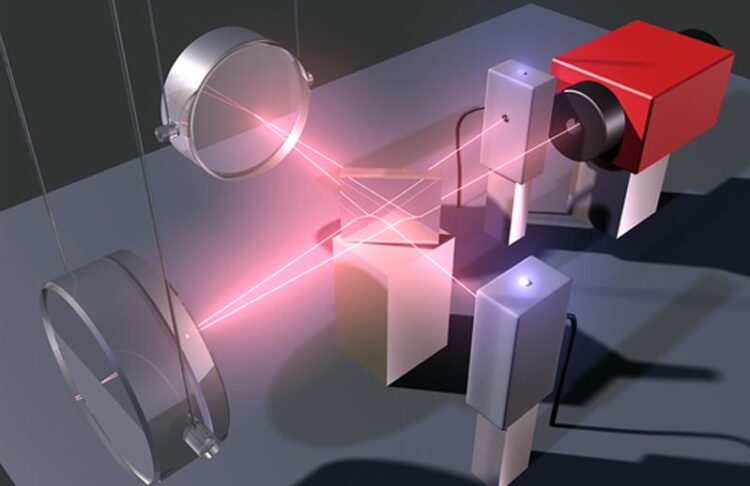Gravitational wave mirror experiments can evolve into quantum entities

Schematic of a laser interferometer used to observe gravitational waves. If the quantum uncertainty of the radiation pressure of the light is the dominant dynamic force acting on the mirrors, a common quantum object arises from the mirror and the reflected light beam. In this case, the sensitivity of the interferometer is optimal when measuring changes in mirror positions due to gravitational waves.
Credit: Alexander Franzen
Quantum physical experiments exploring the motion of macroscopic or heavy bodies under gravitational forces require protection from any environmental noise and highly efficient sensing.
An ideal system is a highly reflecting mirror whose motion is sensed by monochromatic light, which is photoelectrically detected with high quantum efficiency. A quantum optomechanical experiment is achieved if the quantum uncertainties of light and mirror motion influence each other, ultimately leading to the observation of entanglement between optical and motional degrees of freedom.
In AVS Quantum Science, co-published by AIP Publishing and AVS, researchers from Hamburg University in Germany review research on gravitational wave detectors as a historical example of quantum technologies and examine the fundamental research on the connection between quantum physics and gravity. Gravitational wave astronomy requires unprecedented sensitivities for measuring the tiny space-time oscillations at audio-band frequencies and below.
The team examined recent gravitational wave experiments, showing it is possible to shield large objects, such as a 40-kilogram quartz glass mirror reflecting 200 kilowatts of laser light, from strong influences from the thermal and seismic environment to allow them to evolve as one quantum object.
“The mirror perceives only the light, and the light only the mirror. The environment is basically not there for the two of them,” said author Roman Schnabel. “Their joint evolution is described by the Schrödinger equation.”
This decoupling from the environment, which is central to all quantum technologies, including the quantum computer, enables measurement sensitivities that would otherwise be impossible.
The researchers review intersects with Nobel laureate Roger Penrose’s work on exploring the quantum behavior of massive objects. Penrose sought to better understand the connection between quantum physics and gravity, which remains an open question.
Penrose thought of an experiment in which light would be coupled to a mechanical device via radiation pressure. In their review, the researchers show while these very fundamental questions in physics remain unresolved, the highly shielded coupling of massive devices that reflect laser light is beginning to improve sensor technology.
Going forward, researchers will likely explore further decoupling gravitational wave detectors from influences of the environment.
More broadly speaking, the decoupling of quantum devices from any thermal energy exchange with the environment is key. It is required for quantum measurement devices as well as quantum computers.
The article “Macroscopic quantum mechanics in gravitational-wave observatories and beyond” is authored by Roman Schnabel and Mikhail Korobko. The article will appear in AVS Quantum Science on March 15, 2022 (DOI: 10.1116/5.0077548). After that date, it can be accessed at https://aip.scitation.org/doi/full/10.1116/5.0077548.
ABOUT THE JOURNAL
AVS Quantum Science, co-published by AIP Publishing and AVS, is a truly intradisciplinary journal that reaches from its foundations in quantum science into a breadth of areas from condensed matter and atomic, molecular and optical physics, to biology, chemistry, and materials science, as well as computer science and engineering. The journal places a strong emphasis on focused and comprehensive reviews and features perspectives and original research.
ABOUT AVS
AVS is an interdisciplinary, professional society with some 4,500 members worldwide. Founded in 1953, AVS hosts local and international meetings, publishes five journals, serves members through awards, training, and career services programs, and supports networking among academic, industrial, government, and consulting professionals. Its members come from across the fields of chemistry, physics, biology, mathematics, engineering, and business and share a common interest in basic science, technology development and commercialization related to materials, interfaces, and processing. https://www.avs.org
Journal: AVS Quantum Science
DOI: 10.1116/5.0077548
Article Title: Macroscopic quantum mechanics in gravitational-wave observatories and beyond
Article Publication Date: 15-Mar-2022
Media Contact
Larry Frum
American Institute of Physics
media@aip.org
Office: 301-209-3090
All latest news from the category: Physics and Astronomy
This area deals with the fundamental laws and building blocks of nature and how they interact, the properties and the behavior of matter, and research into space and time and their structures.
innovations-report provides in-depth reports and articles on subjects such as astrophysics, laser technologies, nuclear, quantum, particle and solid-state physics, nanotechnologies, planetary research and findings (Mars, Venus) and developments related to the Hubble Telescope.
Newest articles

NASA’s Fermi finds new feature in brightest gamma-ray burst yet seen
In October 2022, astronomers were stunned by what was quickly dubbed the BOAT — the brightest-of-all-time gamma-ray burst (GRB). Now an international science team reports that data from NASA’s Fermi…

Folded peptides are more electrically conductive than unfolded peptides
Researchers combined single-molecule experiments, molecular dynamics simulations and quantum mechanics to validate the findings published in PNAS. What puts the electronic pep in peptides? A folded structure, according to a…

Shining light on similar crystals reveals photoreactions can differ
Distinctive processes could provide hints on how to use next-generation materials. A rose by any other name is a rose, but what of a crystal? Osaka Metropolitan University-led researchers have…





















